推送模式
Sentinel 规则的推送有下面三种模式:

通过前面的讲解,我们已经知道,可以通过 Dashboard 来为每个 Sentinel 客户端设置各种各样的规则,这种属于原始模式。这种模式存在一个问题,就是这些规则默认是存放在内存中的,极不稳定,所以需要将其持久化。

为了达到持久化的目标,我们需要进行改造,改造的方案有两种:本地文件持久化(拉模式)、配置中心持久化(推模式)。
本地文件持久化(拉模式)
拉模式又被称为 pull 模式,它的数据源(如本地文件、RDBMS等)一般是可写入的。本地文件数据源会定时轮询文件的变更,读取规则。这样我们既可以在应用本地直接修改文件来更新规则,也可以通过 Sentinel 控制台推送规则。以本地文件数据源为例,推送过程如下图所示:

首先 Sentinel 控制台通过API将规则推送至客户端并更新到内存中,接着注册的写数据源会将新的规则保存到本地的文件中。使用 pull模式的数据源时一般不需要对Sentinel控制台进行改造。这种实现方法好处是简单,坏处是无法保证监控数据的一致性。
配置yml
#数据库配置
spring:
cloud:
sentinel:
eager: true
transport:
port: 9998 #跟控制台交流的端口,随意指定一个未使用的端口即可
dashboard: localhost:8080 #指定控制台服务的地址
filter:
enabled: false
编写处理类
实现 InitFunc 接口,在 init 中处理 DataSource 初始化逻辑,并利用 SPI 机制实现加载。
public class FilePersistence implements InitFunc {
@Value("${spring.application.name}")
private String applicationName;
@Override
public void init() throws Exception {
//创建规则文件
String ruleDir = System.getProperty("user.home") + "/sentinel-rules/" + applicationName;
String flowRulePath = ruleDir + "/flow-rule.json";
String degradeRulePath = ruleDir + "/degrade-rule.json";
String systemRulePath = ruleDir + "/system-rule.json";
String authorityRulePath = ruleDir + "/authority-rule.json";
String paramFlowRulePath = ruleDir + "/param-flow-rule.json";
this.mkdirIfNotExits(ruleDir);
this.createFileIfNotExits(flowRulePath);
this.createFileIfNotExits(degradeRulePath);
this.createFileIfNotExits(systemRulePath);
this.createFileIfNotExits(authorityRulePath);
this.createFileIfNotExits(paramFlowRulePath);
//流控规则
//创建流控规则的可读数据源
ReadableDataSource<String, List<FlowRule>> flowRuleRDS = new FileRefreshableDataSource<>(flowRulePath,
source -> JSON.parseObject(source, new TypeReference<List<FlowRule>>(){}));
//将可读数据源注册至 FlowRuleManager,这样当规则文件发生变化时,就会更新规则到内存
FlowRuleManager.register2Property(flowRuleRDS.getProperty());
WritableDataSource<List<FlowRule>> flowRuleWDS = new FileWritableDataSource<>(flowRulePath,this::encodeJson);
//将可写数据源注册至 transport 模块的 WritableDataSourceRegistry 中.
//这样收到控制台推送的规则时,Sentinel 会先更新到内存,然后将规则写入到文件中.
WritableDataSourceRegistry.registerFlowDataSource(flowRuleWDS);
//降级规则
ReadableDataSource<String, List<DegradeRule>> degradeRuleRDS = new FileRefreshableDataSource<>(degradeRulePath,
source -> JSON.parseObject(source, new TypeReference<List<DegradeRule>>(){}));
DegradeRuleManager.register2Property(degradeRuleRDS.getProperty());
WritableDataSource<List<DegradeRule>> degradeRuleWDS = new FileWritableDataSource<>(degradeRulePath,this::encodeJson);
WritableDataSourceRegistry.registerDegradeDataSource(degradeRuleWDS);
//系统规则
ReadableDataSource<String, List<SystemRule>> systemRuleRDS= new FileRefreshableDataSource<>(systemRulePath,
source -> JSON.parseObject(source, new TypeReference<List<SystemRule>>(){}));
SystemRuleManager.register2Property(systemRuleRDS.getProperty());
WritableDataSource<List<SystemRule>> systemRuleWDS = new FileWritableDataSource<>(systemRulePath,this::encodeJson);
WritableDataSourceRegistry.registerSystemDataSource(systemRuleWDS);
//授权规则
ReadableDataSource<String, List<AuthorityRule>> authorityRuleRDS = new FileRefreshableDataSource<>(authorityRulePath,
source-> JSON.parseObject(source, new TypeReference<List<AuthorityRule>>(){}));
AuthorityRuleManager.register2Property(authorityRuleRDS.getProperty());
WritableDataSource<List<AuthorityRule>> authorityRuleWDS = new FileWritableDataSource<>(authorityRulePath, this::encodeJson);
WritableDataSourceRegistry.registerAuthorityDataSource(authorityRuleWDS);
//热点参数规则
ReadableDataSource<String, List<ParamFlowRule>> paramFlowRuleRDS = new FileRefreshableDataSource<>(paramFlowRulePath,
source-> JSON.parseObject(source, new TypeReference<List<ParamFlowRule>>(){}));
ParamFlowRuleManager.register2Property(paramFlowRuleRDS.getProperty());
WritableDataSource<List<ParamFlowRule>> paramFlowRuleWDS = new FileWritableDataSource<>(paramFlowRulePath,this::encodeJson);
ModifyParamFlowRulesCommandHandler.setWritableDataSource(paramFlowRuleWDS);
}
}
-
FileRefreshableDataSource:每次更新规则时自动读取持久化文件更新到map缓存。
-
FileWritableDataSource:写数据源,将 sentinel 控制台发送过来的规则信息写到持久化文件中。在客户端的socket接收到规则信息后,更新缓存的时候也会将规则信息写入文件中持久化。
添加配置
在resources下创建配置目录 META-INF/services,然后添加文件com.alibaba.csp.sentinel.init.InitFunc,在文件中添加配置类的全路径it.aq.cheetah.config.FilePersistence。
这样当在 Dashboard 中修改了配置后,Dashboard 会调用客户端的接口修改客户端内存中的值,同时将配置写入文件中,这样操作的话规则是实时生效的,如果是直接修改文件中的内容,这样需要等定时任务3秒后执行才能读到最新的规则。接下来我们演示下:
演示
编写测试类
@RestController
@RequestMapping("/product2")
@Slf4j
public class ProductController2 {
@RequestMapping("/test")
@SentinelResource(value = "test")
public String test() {
return "product2";
}
}
启动项目,发现在目录下生成了空的规则文件

在页面上增加流控规则
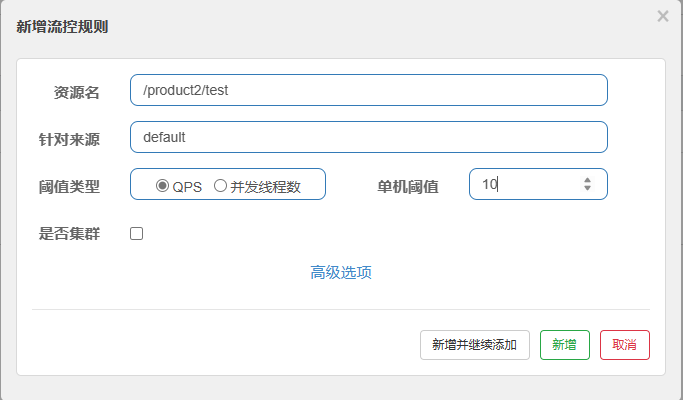
然后去看文件flow-rule.json,发现存到了本地文件中
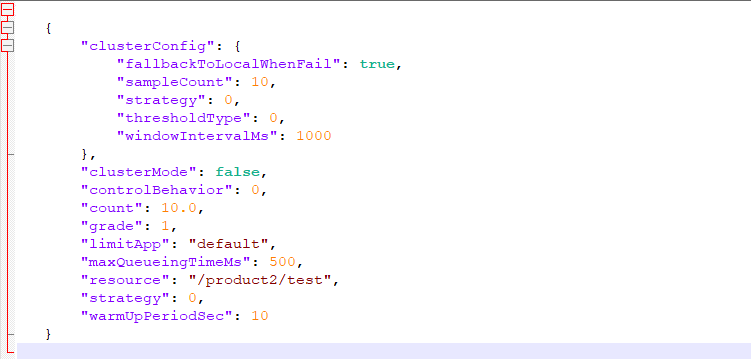
接着我们仿照该规则仿写一个熔断规则,然后查看网页数据确实生效了

配置中心持久化(推模式)
推模式又叫 Push 模式,它是通过注册中心实现的,Sentinel控制台——>配置中心——>Sentinel数据源——>Sentinel

用户不仅可以通过sentinel控制台进行更新,也可以通过nacos配置中心进行更新,所以在sentinel控制台或nacos中修改规则后,都需要通知对方刷新最新的配置。
修改nacos在sentinel中生效
引入依赖
我们在之前项目的基础上引入新的依赖
<!--nacos配置中心-->
<dependency>
<groupId>com.alibaba.cloud</groupId>
<artifactId>spring-cloud-starter-alibaba-nacos-config</artifactId>
</dependency>
<!--以nacos作为sentinel数据源的依赖-->
<dependency>
<groupId>com.alibaba.csp</groupId>
<artifactId>sentinel-datasource-nacos</artifactId>
</dependency>
配置文件
nacos 配置:因为我们用nacos作为了配置中心,我们可以将sentinel的基本配置放入到nacos中就可以了,所以当前服务的yml配置文件中只需要写一些基本的配置就可以了。
spring:
cloud:
nacos:
discovery:
server-addr: localhost:8848
config:
server-addr: localhost:8848
file-extension: yml
在nacos中配置sentinel信息
spring:
cloud:
sentinel:
transport:
# 跟控制台交流的端口,随意指定一个未使用的端口即可
port: 9998
# 指定控制台服务的地址
dashboard: localhost:8080
# sentinel用nacos作为数据源的配置
datasource:
#流控管理(这个名称可以自定义)
flow-control:
# 告诉sentinel用nacos作为数据源
nacos:
# 配置中心里执行文件的 dataId
dataId: shop-product-flow.json
# nacos的地址
serverAddr: 127.0.0.1:8848
# 指定文件配置的是哪种规则
rule-type: flow
注意:如果使用的 namespace 不是默认的,记得配置 namespace 参数。
-
dataId:需要告诉 sentinel 读取配置中心中的哪个配置文件;
-
rule-type:告诉 sentinel 配置文件配置的控制规则,flow:流控、degrade:熔断、param-flow 热点参数,想看有哪些规则参数可以查看
com.alibaba.cloud.sentinel.datasource包下的枚举类:RuleType。
public enum RuleType {
/**
* flow.
*/
FLOW("flow", FlowRule.class),
/**
* degrade.
*/
DEGRADE("degrade", DegradeRule.class),
/**
* param flow.
*/
PARAM_FLOW("param-flow", ParamFlowRule.class),
/**
* system.
*/
SYSTEM("system", SystemRule.class),
/**
* authority.
*/
AUTHORITY("authority", AuthorityRule.class),
/**
* gateway flow.
*/
GW_FLOW("gw-flow",
"com.alibaba.csp.sentinel.adapter.gateway.common.rule.GatewayFlowRule"),
/**
* api.
*/
GW_API_GROUP("gw-api-group",
"com.alibaba.csp.sentinel.adapter.gateway.common.api.ApiDefinition");
shop-product-flow.json文件中配置【流控规则】
[
{
"clusterConfig": {
"acquireRefuseStrategy": 0,
"clientOfflineTime": 2000,
"fallbackToLocalWhenFail": true,
"resourceTimeout": 2000,
"resourceTimeoutStrategy": 0,
"sampleCount": 10,
"strategy": 0,
"thresholdType": 0,
"windowIntervalMs": 1000
},
"clusterMode": false,
"controlBehavior": 0,
"count": 10.0,
"grade": 1,
"limitApp": "default",
"maxQueueingTimeMs": 500,
"resource": "/product2/test",
"strategy": 0,
"warmUpPeriodSec": 10
}
]

然后去 dashboard 中查看,发现流控规则已经在控制中显示了

目前我们已经实现了在 nacos 中配置的文件直接在sentinel dashboard中生效,但是我们在sentinel dashboard中修改了配置,nacos 是不会监听到并进行修改的。接下来我们实现一下通过 sentinel 控制台设置的规则直接持久化到 nacos配置中心。
修改sentinel在nacos中生效
Sentinel 控制台提供 DynamicRulePublisher 和 DynamicRuleProvider 接口用于实现应用维度的规则推送和拉取。
下载源码
https://github.com/alibaba/Sentinel/releases下载dashboard的代码源码。
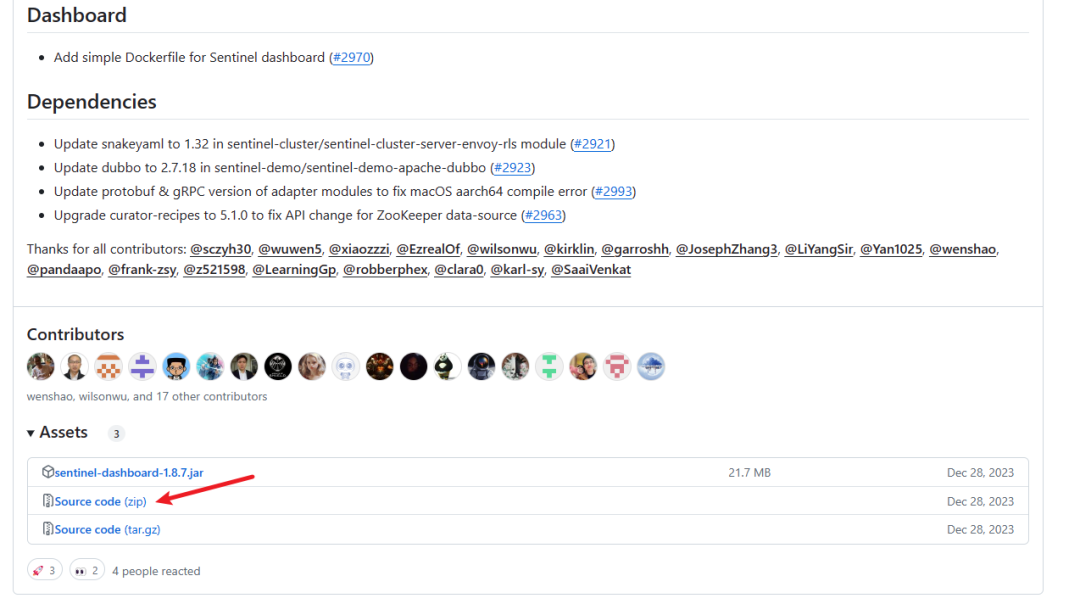
解压之后打开sentinel-dashboard项目,将 pom.xml 文件中作用域为 test 的注释掉,注释掉后默认的作用域为 compile。
-
test:作用域表示该依赖项只在测试时有用,在编译和运行时不会被用到。
-
compile:作用域范围的依赖项在所有情况下都是有效的,包括编译、运行和测试。
把 test 包下的两个类复制过来
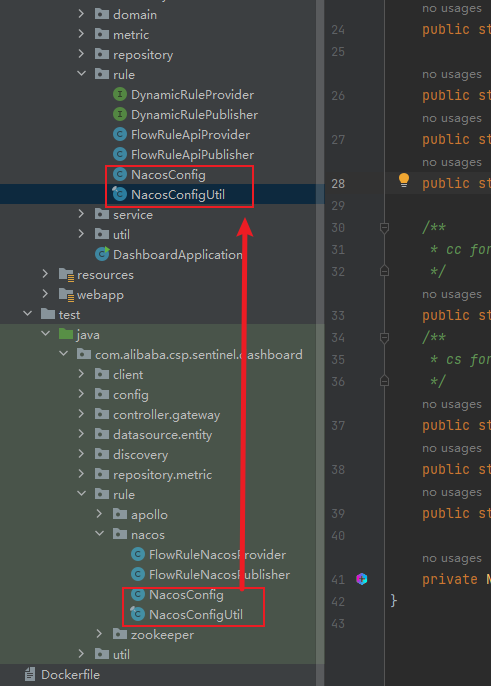
-
NacosConfigUtil类主要就是 nacos 配置的规则,比如配置文件的后缀,分组Group_ID等等。因为我用的分组是默认分组,所以改为DEFAULT_GROUP,我之前的规则文件是shop-product-flow.json,所以我把规则文件后缀FLOW_DATA_ID_POSTFIX改为"-flow.json"。 -
NacosConfig类是为了注入nacos的信息以及转换器类。
更改代码
application.properties 中增加 nacos 的配置
# nacos 配置
nacos.serverAddr=localhost:8848
nacos.username=nacos
nacos.password=nacos
NacosConfig 修改为从配置文件中获取nacos配置
@Bean
public ConfigService nacosConfigService() throws Exception {
Properties properties = new Properties();
//Nacos地址
properties.put("serverAddr", serverAddr);
//Nacos用户名
properties.put("username", username);
//Nacos密码
properties.put("password", password);
return ConfigFactory.createConfigService(properties);
}
在com.alibaba.csp.sentinel.dashboard.rule.FlowRuleApiPublisher#publish方法中增加推送到nacos的逻辑代码
//将规则推送到nacos
configService.publishConfig(app + NacosConfigUtil.FLOW_DATA_ID_POSTFIX,
NacosConfigUtil.GROUP_ID, converter.convert(rules));
在com.alibaba.csp.sentinel.dashboard.rule.FlowRuleApiProvider#getRules方法中修改为从nacos中读取配置的逻辑
@Override
public List<FlowRuleEntity> getRules(String appName) throws Exception {
String rules = configService.getConfig(appName + NacosConfigUtil.FLOW_DATA_ID_POSTFIX,
NacosConfigUtil.GROUP_ID, 3000);
if (StringUtil.isEmpty(rules)) {
return new ArrayList<>();
}
return converter.convert(rules);
}
改造流控的controller类FlowControllerV1,将配置保存到内存中的逻辑改为保存到nacos中
@Autowired
@Qualifier("flowRuleDefaultProvider")
private DynamicRuleProvider<List<FlowRuleEntity>> ruleProvider;
@Autowired
@Qualifier("flowRuleDefaultPublisher")
private DynamicRulePublisher<List<FlowRuleEntity>> rulePublisher;
@GetMapping("/rules")
@AuthAction(PrivilegeType.READ_RULE)
public Result<List<FlowRuleEntity>> apiQueryMachineRules(@RequestParam String app,
@RequestParam String ip,
@RequestParam Integer port) {
......
try {
// List<FlowRuleEntity> rules = sentinelApiClient.fetchFlowRuleOfMachine(app, ip, port);
//从nacos中读取规则
List<FlowRuleEntity> rules = ruleProvider.getRules(app);
rules = repository.saveAll(rules);
return Result.ofSuccess(rules);
} catch (Throwable throwable) {
logger.error("Error when querying flow rules", throwable);
return Result.ofThrowable(-1, throwable);
}
}
private void publishRules(String app, String ip, Integer port) throws Exception {
//将规则推送到nacos
List<FlowRuleEntity> rules = repository.findAllByApp(app);
rulePublisher.publish(app, rules);
// List<FlowRuleEntity> rules = repository.findAllByMachine(MachineInfo.of(app, ip, port));
// return sentinelApiClient.setFlowRuleOfMachineAsync(app, ip, port, rules);
}
//其余调用publishRules方法的地方做下简单调整
演示
启动当前项目,流控规则中存在我们之前在nacos中创建的文件,我们将原来的单机阈值从10改为12,然后保存。查看nacos中配置文件的数据,发现已经生效了。
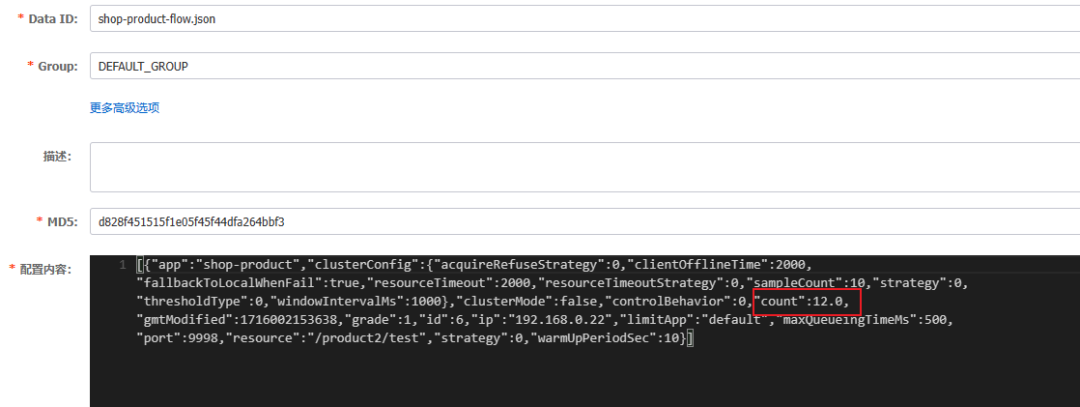
至于其他规则,大家可以自行实现,此处就不一一实现了

总结
到这儿,服务容错中间件Sentinel的两种持久化模式就已经介绍完了。下一篇将为大家带来Feign整合容错组件 Sentinel 的文章,敬请期待吧!





















 469
469

 被折叠的 条评论
为什么被折叠?
被折叠的 条评论
为什么被折叠?








